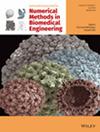Improved Mechanical Support Parametrization to Predict the Renal Ostia Displacement Induced by Tools Insertion in EVAR
Abstract
To improve the prediction of renal ostia displacement in biomechanical finite element simulations of the vascular structure deformation during endovascular aneurysm repair (EVAR). An existing finite element model to compute the deformation of the vascular structure due to tools insertion during EVAR, previously validated against clinical data in terms of guidewire position, is confronted in terms of renal ostia displacement to clinical intraoperative data from 16 patients undergoing EVAR and experiencing significant ostia displacement during the procedure (average vertical displacement of 10.38 mm from the preoperative to intraoperative configurations). This yields an update of the mechanical support parametrization. A score quantifies the predictive performance of the existing and updated parametrizations for both the renal displacement and the iliac arteries deformation. The updated model demonstrates a significant improvement in predictive accuracy for renal ostia deviation during EVAR. The axial mean displacement error is improved from 7.41 mm (previous parametrization) to 2.99 mm (updated parametrization). The score shows that this new parametrization improves the predictive performance of the simulation for the renal ostia displacement without compromising the iliac deformations prediction. The updated parametrization significantly enhances the predictive capability for arterial deformations during EVAR. A better prediction of the renal ostia displacement can significantly improve surgical planning and intraoperative guidance.


 求助内容:
求助内容: 应助结果提醒方式:
应助结果提醒方式:


